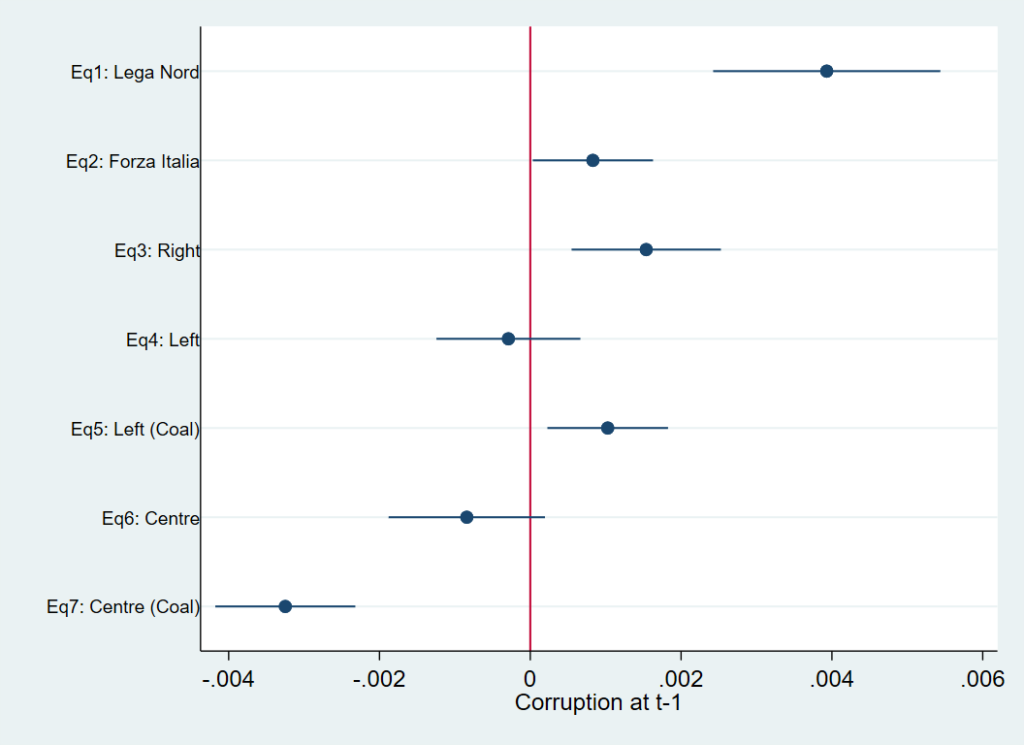The rise of populist parties in the aftermath of a massive corruption scandal
Foresta A., 2020 – Public Choice
In the past few years, the rise of populism has been one of the main features of European and American politics. Parties such as the Lega Nord (Northern League) in Italy, Sverigedemokraterna (Swedish Democrats) in Sweden, and Alternative für Deutschland (Alternative for Germany) in Germany have achieved historic results in recent decades. Regardless of geographical and political differences, populist parties share some general traits. One of the characteristics is the rhetoric of “us against them,” as illustrated by the Lega Nord’s slogan ‘Roma Ladrona’ (Thieving Rome) in the 1990s. According to Cas Mudde, populism can be defined as “an ideology that considers society to be ultimately separated into two homogeneous and antagonistic groups, the pure people versus the corrupt elite.”
In a recent article entitled “The Rise of Populist Parties in the Aftermath of a Massive Corruption Scandal” and published in Public Choice, Alessandra Foresta investigates the relationship between the exposure to corruption scandals and the rise of populist parties in Italy. This work is focused on the role of a massive corruption scandal of the 1990s known as Tangentopoli (or Mani Pulite, “Clean Hands”) in the rise of one of the largest populist parties, the Lega Nord. Tangentopoli is particularly relevant in the Italian history because it represents a major cause for the collapse of postwar Italian political parties such as the Partito Socialista Italiano (Italian Socialist Party, PSI) and Democrazia Cristiana (Christian Democrats, DC), at both the local and the national level. Their disappearance paved the way for new parties, like Forza Italia and Lega Nord, to gain consensus in Italian politics. The author focuses on the role of local corruption scandals in the rise of these parties in national elections.
To perform the empirical analysis, the author built a novel dataset focusing on corruption detected at the municipal level. The dataset was constructed exploiting an online archive (specifically, the DEA archive) provided by ANSA, the Agenzia Nazionale Stampa Associata (Associated Press National Agency), which is the primary Italian press agency. The author conducted searches using the term ’corruzione’ (corruption) in conjunction with the names of all municipalities included in the sample. She next counted the news articles that contained these keywords and generated a variable for the presence of corruption measured at the municipal level in a given year. Subsequently, the dataset was integrated with information on election data and the demographic structure of the population.
The identification strategy relies on a series of regressions that take the dependent variable to be the logarithm of the vote shares of various political parties/coalitions, such as Lega Nord, Forza Italia, Right, Left, Left (Coal.), Centre, and Centre (Coal.). To account for potential confounding factors, all the regressions incorporate control variables at the municipal level, alongside fixed effects for municipality, year, and province. Results are presented in Figure 1.

The most compelling results are observed for Lega Nord, Forza Italia, and the Right. The coefficients consistently exhibit positive and significant values. These parties/coalitions manage to leverage voters’ dissatisfaction with corruption scandals, effectively translating it into an increased number of votes. While results are aligned with the challenger-effect theory, the outcomes for the populist challenger, Lega Nord, are particularly noteworthy, setting it apart from other radical right-wing parties and outsider factions.
Furthermore, the results confirm that the Center (Coal.), which was the major incumbent prior to Tangentopoli, faced substantial penalties due to corruption exposure. An intriguing discovery emerges when comparing Center with Center (Coal.). While Center (Coal.) is perceived as being responsible and subjected to punishment, the estimated coefficient for Center is not statistically significant, albeit negative. One plausible explanation could be the successful re-branding efforts undertaken by many former DC politicians. Moving on, the coefficient for Left is modestly negative, yet not statistically significant, while the coefficient for Left (Coal.) is both positive and significant. A potential rationale for the distinction between Left and Left (Coal.) lies in the latter’s ability to more effectively exploit the discontent with the major incumbent, through the inclusion of other previously marginalized parties (e.g. the Green Party). On the contrary, the Left seems to suffer due to its association with the system.
However, local politics can exert an influence on national electoral outcomes. To further validate the results, the analysis is replicated by incorporating a dummy variable for local political affiliation, along with the interaction of this dummy with the corruption variables. The conclusions drawn from this supplementary analysis closely resemble those presented in Figure 1.
Overall, the results support the hypothesis that being the populist challenger confers a distinctive political competitive advantage when faced with corruption scandals, setting it apart from other challenger parties.
This analysis holds significant relevance for contemporary political analysis, shedding light on the factors that contribute to the appeal of populist parties in the eyes of voters. Furthermore, this study helps to clarify the broader implications of corruption, stretching beyond mere concerns of wasting public funds. It underscores how corruption undermines trust between the political establishment, elites, and voters. Once this trust is eroded, voters seek alternative options and are attracted by easy promises made by populist parties. Further investigation into this relationship is imperative to grasp the ongoing substantial shifts in political and party systems not only in Italy but also in Europe and in the rest of the world.

